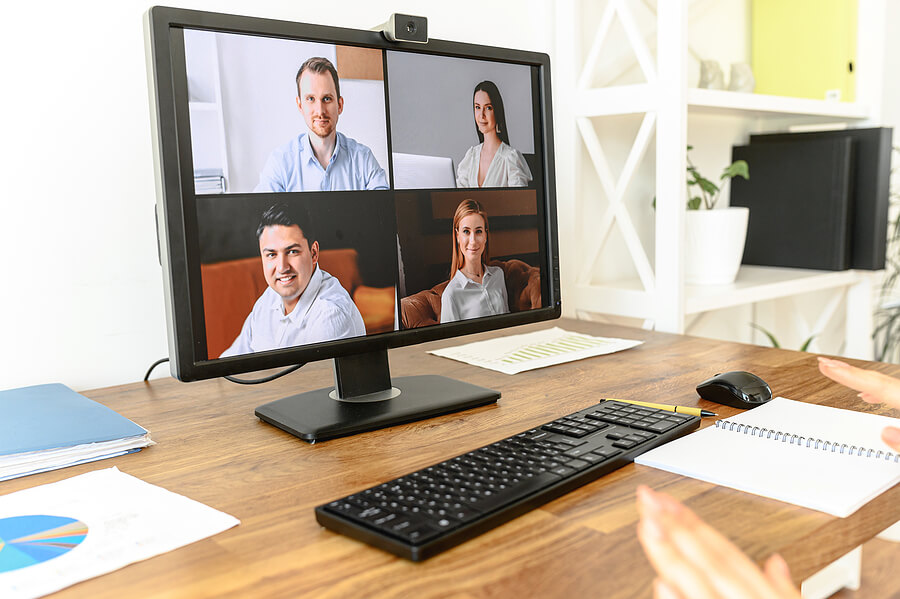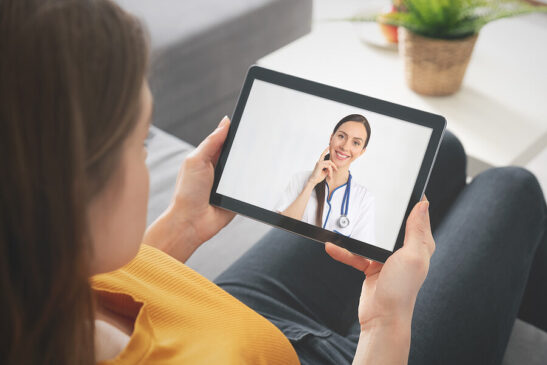Living in a pandemic, like living with vision loss, rattles our confidence and upends our sense of security. We have little choice but to accept the change and adjust to a new normal. In both scenarios it would be well-advised to embrace technology. Digital access is not an option today, it is a necessity. As the COVID shutdown curtailed major segments of daily activity, the internet opened, enabling us to order food deliveries, stay in touch with loved ones, visit doctors by video, work remotely and educate online.
Before the pandemic, patients with vision loss were counseled against isolating or social distancing. Now both behaviors are widely encouraged to keep everyone healthy and well. With faces partially hidden behind the safety of a mask, the ability to read expressions and recognize others is a problem suddenly affecting the population at large.
It would be fair to assume that the added restrictions would elevate the degree of difficulty for people with low vision. The downside appeared very steep for many in the early days, but as we settled into this new reality, it became clear there were some silver linings.
Zoom Video
The now ubiquitous Zoom video conferencing platform will likely go down in history as the pandemic MVP. It stepped in to fill a potentially massive void with a virtual, and COVID-proof, face to face connection. The technology kept work and school ongoing remotely. It allowed for family gatherings, dinner with friends, support group meetings and therapy sessions.
And for those of us with central vision loss, it gave back an ability to see peoples’ faces more clearly than we had in years. I can attest to this experience as a patient with a visual acuity long documented as “counting fingers.” It’s amazing to zoom in and see someone’s facial details more vividly on a digital screen than if they had been sitting right beside me. It did not take long to find others also enjoying the gift of “Zoom acuity.”
Video calls can be accessed either on a smartphone, tablet or computer screen. Far more opportunities have opened up through this medium. People can now attend conferences, seminars and trainings online without the significant expense and travel requirement. Museums can conduct virtual and accessible tours, allowing their patrons in for the closest look at art ever. These are just a few examples of how virtual engagements are expanding.
Pandemic safety precautions pushed us, visually impaired or not, to embrace digital options to maintain daily life. Here are some of the highlights.
Online Deliveries
Navigating a grocery store was never an enjoyable activity for people with vision loss. The pandemic necessitated a vast expansion of online delivery options, so shopping doesn’t have to be arduous anymore. Most of these services offer same-day delivery or curbside pick-up. Services like Instacart, Shipt and Prime Now also make it possible to communicate with the shopper to insure you’re getting exactly what you want. Once these accounts are set up and products are purchased, it becomes easier to repeat orders by accessing your previous lists. Amazon even has an Accessibility Customer Service Line, for customers with visual impairments, to assist with online shopping. The same goes for ordering take-out from restaurants for delivery through Seamless, Uber Eats and DoorDash. Generally, customers find this a better way and it is likely that most will continue with online deliveries in the long-term.
Work from Home
The shift to work from home (WFH) happened on a scale and at a speed we would not have imagined achievable. The benefits of this arrangement may even exceed its original purpose of flattening the curve of COVID19 cases. According to Gallup (April 2020), a majority of employees would like to continue WFH even when the pandemic ends . For employees and job seekers with vision loss, the upside is that flexibility and quality of life is being widely recognized resulting in more opportunities. We discussed WFH in on the OE Patients Podcast (September 2020) and our experienced panel also agreed this development will serve to improve employment opportunities for people with visual impairments.
Telehealth
Patients quickly found telehealth calls and video visits quite appealing as a pandemic alternative with the understanding that they can supplement but not replace in-person visits. On the OE Patients Podcast (June 2020) Allen C. Ho, MD, a retina specialist, discussed better utilization for video visits beyond triaging the need for urgent care. He introduced us to the new hybrid visit being studied, which combines a quick in-person appointment for a fundus photo and OCT scan, followed by a video call with the provider to assess the images and talk with the patient. The result is efficient, high quality and safe patient care. Dr. Ho said, “I see healthcare moving more toward at-home and remote services enabled by technology and accelerated by the pandemic of COVID19.” Our listeners respond very favorably to more convenience and less time in waiting rooms.
Embrace Technology
The common thread throughout these examples of the pandemic silver linings is the use of technology. It is all within the grasp of anyone using a smartphone or tablet. With built-in visual and speech features these devices well-accommodate the needs of patients across the spectrum of vision loss. Age is less of a barrier than one might imagine. Pew Research (2019) shows 73% of people over 65 were Internet users, with screen time over 4 hours per day. We expect significant growth in internet usage for 2020, mainly driven by the pandemic.
Considering the number of Americans with low vision is projected to double by 2050, the American Academy of Ophthalmology stated in a press release (September 2019), “the tragedy isn’t that people have lost vision, it’s that most believe nothing can be done to improve their quality of life.” This is not true and AAO recommends patients make small changes that have positive impact and embrace technology.
Patients look to professionals for advice. Physicians and healthcare providers play an influential role in encouraging patients’ digital acceptance and preparedness. It is the key to maintaining independence and an all-important sense of normal.
Accessibility Resources:
- Apple Accessibility support: (877) 204-3930
- Amazon Accessibility Customer Service: (888) 283-1678
- Verizon Wireless Accessibility: (888) 262-1999
- OEPatients.org: Practical tips and empowering advice for living better with vision loss.
- HadleyHelps.org: Large selection of accessible technology tutorials and access to live expert help.











